Looking In The Telescope, Preparing For The Threat – IELTS Reading Answers
15 min read
Updated On
-
Copy link
Table of Contents

Limited-Time Offer : Access a FREE 10-Day IELTS Study Plan!
The IELTS Reading Practice Test 53 with Answer keys is a great help to the students who are taking up IELTS examinations. There is a sample of questions that appear in the actual IELTS test which will help them to improve their reading skills.
We at IELTSMaterial.com would urge every IELTS aspirant to time this test as in the real exam and find the answers without looking at the key. If you have scored 40/40, then we wish you all the best. If you haven’t, then we would earnestly advise you to take one of our IELTS reading practice tests.
Reading Passage 1
You should spend about 20 minutes on Questions 1-13 which are based on Reading Passage 1.
Looking In The Telescope

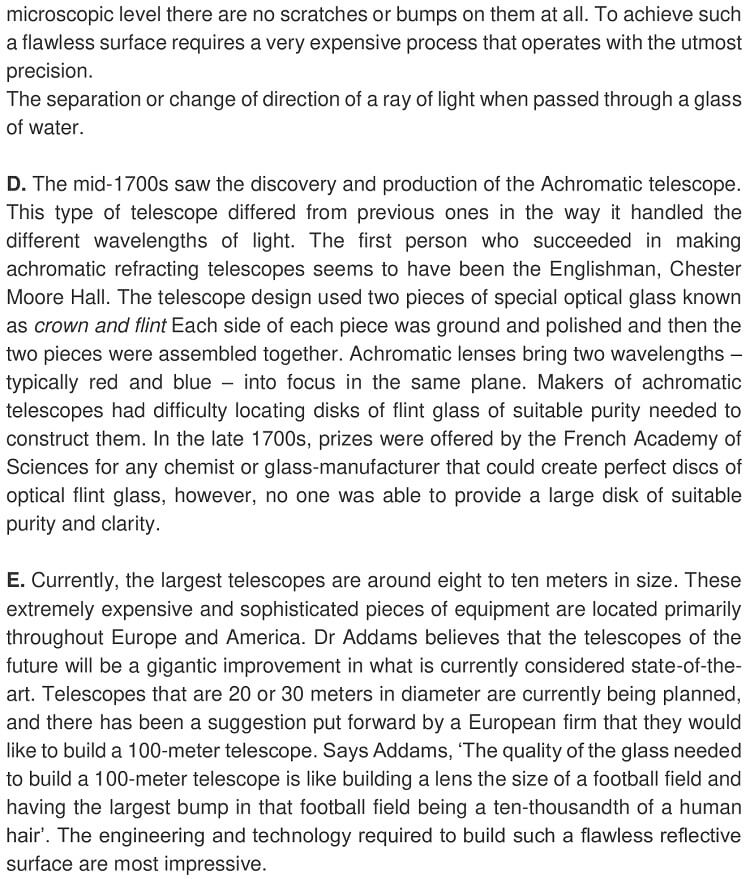
[do_widget id=custom_html-23]
Questions 1-5
Choose the correct letter, A, B, C or D and Write the correct letter next to the questions 1-5 on your answer sheet.
1 According to the writer, the first telescope was
A invented by children.
B made by a lens maker.
Ca reflective telescope.
D quite a complex piece of equipment.
2 The writer states that Galileo
A improved on the design of the first telescope.
B created the first reflective telescope.
C took 24 hours to make a reflective telescope.
D allowed people to see 3 times further than the first telescope.
3 The Galileo telescope was better than the first telescope because of it
A used mirrors rather than glass.
B was longer than the first telescope.
C used better lens positioning and quality.
D used better quality lenses and glass.
4 The writer states that today large telescopes are
A 20 or 30 meters in size.
B as big as 100 meters.
C very costly items.
D as good as will ever be built.
5 Large, powerful telescopes are difficult to build because
A designs have not changed in nearly 100 years.
B it is difficult to locate the flint glass needed for them.
C the area needed to house the telescope is simply too large.
D the lenses must be extremely reflective.
Questions 6-10
Classify the following features as belonging to
- the Achromatic telescope
- the Reflective telescope
- the Refracting telescope
Write the correct letter A, B or C, in boxes 6-10 on your answer sheet.
6 The first telescopes made.
7 It uses a series of lenses one on top of the other.
8 Highly polished lenses.
9 The first use of mirrors to collect light.
10 Two pieces of glass stuck together
Questions 11-13
Complete the summary below using words from the passage.
Choose NO MORE THAN THREE WORDS from the passage for each answer.
Write your answers in the blank spaces next to 11-13 on your answer sheet.
There have been a number of changes in telescopes since they were first invented. For example, Galileo’s telescope increased magnification of the previously made telescope by a factor of 30. He did this by altering the lenses 11_______________ and also constructing lenses 12______________. Other improvements followed but the most significant step forward, and still a major factor today in telescope design, has been the inclusion of 13_______________.
Also check:
- IELTS Reading
- Tips to Improve IELTS Reading Skills
- IELTS Academic Reading Practice test
- True False Not Given IELTS Reading
- IELTS Reading recent actual test
- IELTS past paper pdf
Reading Passage 2
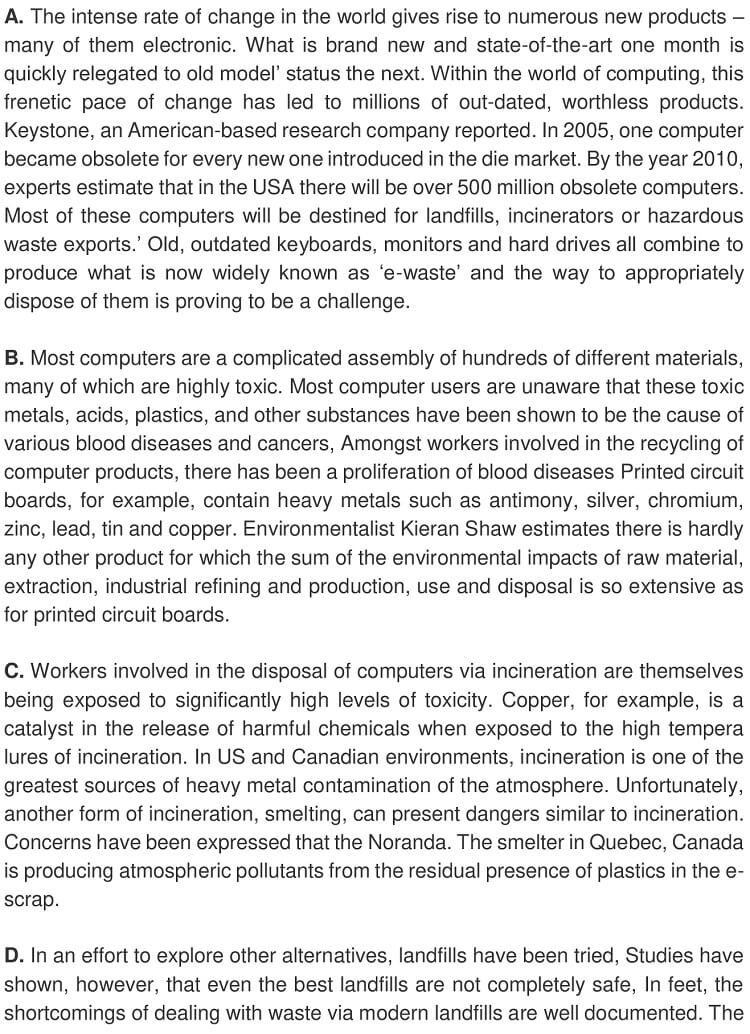
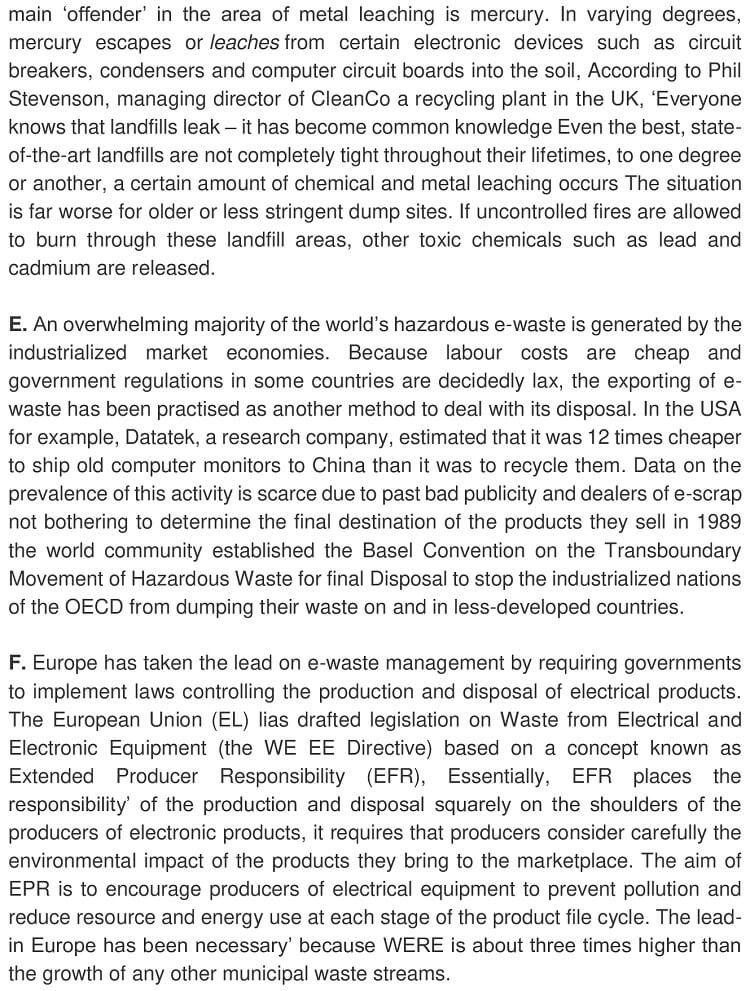
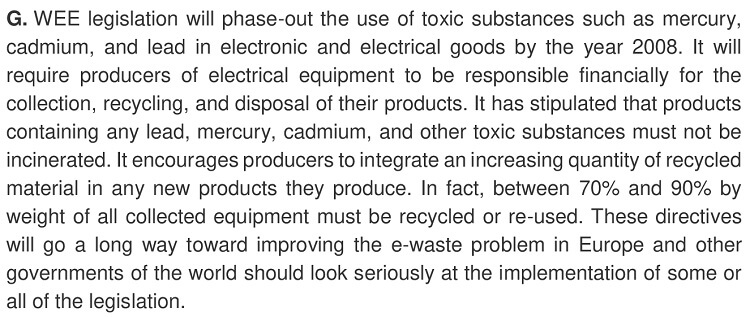
Questions 14-20
Reading Passage 2 has 7 paragraphs, A-G.
Choose the correct heading for each paragraph from the list of headings below.
Write the correct number, i-xi, in boxes 14-20 on your answer sheet.
List of Headings
- Exporting e-waste
- The hazards of burning computer junk
- Blame developed countries for e-waste
- Landfills are not satisfactory
- Producer’s legal responsibility
- The dangers of computer circuit boards
- Electronic changes bring waste
- European e-waste laws
- The dangerous substances found in computers
- Landfills and mercury leaching
- New products must contain recycled products
14 Paragraph A
15 Paragraph B
16 Paragraph C
17 Paragraph D
18 Paragraph E
19 Paragraph F
20 Paragraph G
Questions 21-24
Look at the following list of statements (Questions 21-24) and the list of companies below.
Match each statement with the correct company.
Write the correct letter A-D in boxes 21-24 on your answer sheet.
NB You may use any letter more than once.
21 waste sites without strict dumping rules lead to big problems
22 e-waste should be re-located to other countries
23 most old computers will be buried or burned
24 it is impossible to contain metal waste in soil
List of companies
A Noranda Smelter
B Datatek
C Keystone
D CleanCo
Questions 25 -27
Choose THREE letters, A-G, and Write the correct letters next to the questions 25-27 on your answer sheet.
According to the information in the text, which THREE of the following pollution laws have been proposed in Europe?
AManufacturers will have to pay for the disposal of their products.
B Manufacturers must dispose of the electronic goods they produce.
C Products made in Europe must be completely recyclable.
D Consumers are responsible for the disposal of the products they purchase.
E Disposal of products containing mercury should be incinerated.
F Other governments around the world will implement EU laws.
G A large percentage of old products must be included in new products.
Reading Passage 3
Preparing For The Threat

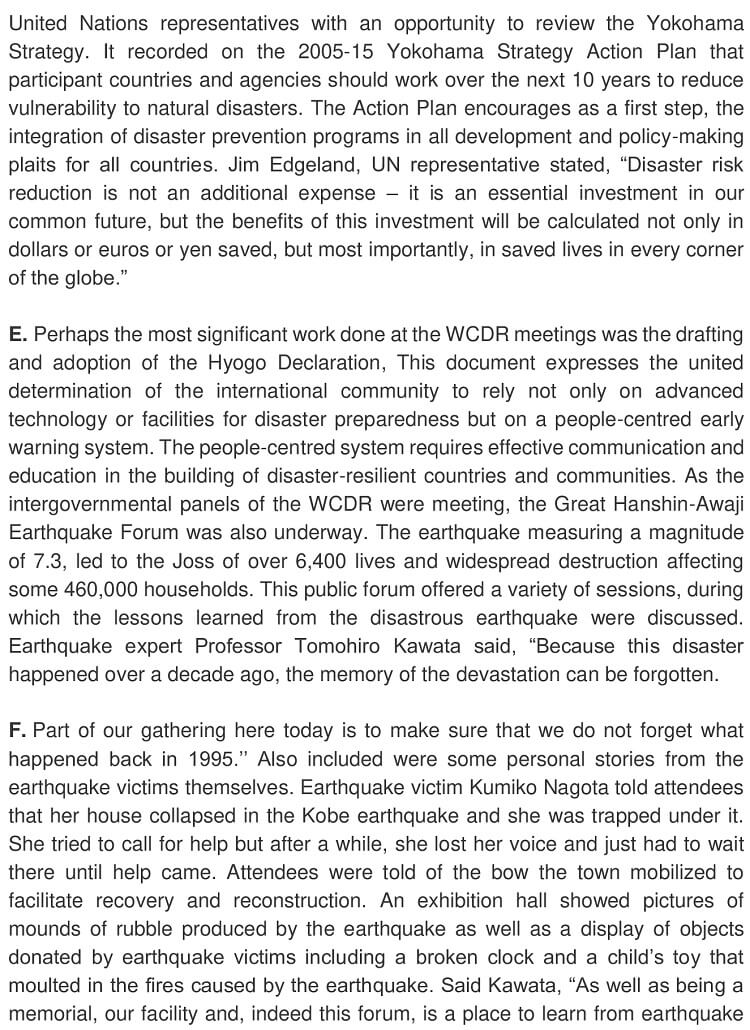

Questions 28-31
Do the following statements agree with the information given in Reading Passage 3?
In boxes 28-31 on your answer sheet, write
TRUE, if the statement agrees with the information
FALSE, if the statement contradicts the information
NOT GIVEN, if there is no information on this
28 Mostly people from poorer countries are affected by natural disasters.
29 Present-day natural disasters are more dangerous than disasters of the past.
30 It will take the countries affected by the tsunami many years to rebuild.
31 Being prepared and knowing what to do in a disaster should be a global issue.
Questions 32-35
Choose the correct letter, A, B, C or D and Write the correct letter next to the questions 32-35 on your answer sheet
32 According to the passage, reducing the risk of disasters is important because
A countries can then focus on growth and development.
B communities will be drawn together in support of each other.
C help international communities to be more economically stable.
D it will save lives and money.
33 According to the writer, the most important outcome of the World Conference on Disaster Reduction (WCDR) was the
A discussion and debate amongst the international community attendees.
B a chance for participants to review the Yokohama Strategy.
C writing and acceptance of the Hyogo Declaration.
D acknowledgement that disaster risk reduction is an investment in the future.
34 The town of Kobe was effectively rebuilt due to
A the support of the United Nations.
B the people of Kobe.
C the Government of Japan.
D the leadership of Professor Kawata.
35 The stated purpose of the Great Hanshin-Awaji Earthquake Forum was
A to help others Ire better prepared for any future natural disasters.
B for people to learn more about natural disasters.
C to remember the Kobe earthquake of 1995.
D for people to remember and the team from what happened.
Questions 36-40
Look at the following statements (Questions 36 – 40) and the list of disaster control initiatives below.
Match each statement with the correct disaster control initiative, A-D.
Write the correct letter, A-D, in boxes 36-40 on your answer sheet.
36 people should be the early broadcasters of disaster information
37 led to a new central area for support in disaster recovery
38 a reminder of the impact of disasters
39 in times of disaster, developed countries should do more to help less-developed countries
40 national development and disaster prevention should be considered at the same time
Disaster Control Initiatives
A Hyogo Declaration
B Great Hanshin-Awaji Earthquake Forum
C World Conference on Disaster Reduction
D Yokohama Strategy for a Safer World
Answers
Unlock Answer
Signup/Login and get access to the answers
Looking In The Telescope Reading Answers (Passage 1)
| 1 | B
A is not correct because the text says that children were fooling around and that “Hans Lippershey, the Dutch lensmaker… credits children as having been his motivation for the invention of the first telescope”. This is an indirect way of saying that Hans invented the telescope. Paragraph 2 also states that Galileo “improved on Lippershey’s telescope”. |
| 2 | A
B & C are wrong because the telescope Galileo designed was a refracting telescope. D is wrong because Galileo’s telescope allowed people to see 30 times further. |
| 3 | C
A is wrong because Galileo’s telescope did not use mirrors, that came later. B. is obviously the wrong D is wrong because although he used better quality lenses, the other half of the reason was because of the positioning of the lenses. |
| 4 | C
A is wrong because it says that 20 or 30 meters “are currently being planned” in other words, they have not been built yet. B. is wrong for the same reason as A. D is the opposite of what is written: “Dr Addams believes that the telescopes of the future will be a gigantic improvement in what is currently considered state-of-the-art.” |
| 5 | D
A is a correct statement but has nothing to do with why large telescopes are difficult to build. B is also a correct statement but flint is not used in the construction of modern telescopes. C is simply false. |
| 6 | C
The tools used in the manufacturing of the first Refracting telescope were all Galileo need to know and within 24 hours he had developed a better one. In fact, the process of improvements Galileo made on Lippershey’s telescope was quite dramatic. |
| 7 | C
Paragraph 1 talks about the refracting telescope: ‘They noticed that when they placed lenses one on top of the other, they were able to see a considerable distance.’
|
| 8 | A
The 4th paragraph: ‘The telescope design used two pieces of special optical glass known as crown and flint glass. Each side of each piece was ground and polished, and then the two pieces were assembled together.’ |
| 9 | B
Talking about the Reflective telescope in paragraph 3: ‘…lenses used for magnification in telescopes were replaced by mirrors.’ |
| 10 | A
In the 4th paragraph: ‘The telescope design used two pieces of special optical glass known as crown and flint glass.’ |
| 11 | positions
The 2nd paragraph states: ‘Galileo achieved these extraordinary results by figuring out the combination of the positions of the lenses and also by making his own lenses which were of better quality.’ |
| 12 | of better quality
The 2nd paragraph states: ‘Galileo achieved these extraordinary results by… making his own lenses which were of better quality. |
| 13 | mirrors
The 3rd paragraph states: ‘Thus, lenses used for magnification in telescopes were replaced by mirrors. Mirrors have since been the standard for telescopes.’ |
Reading Passage 2
| 14 | vii
Paragraph A discusses in the first sentence (i.e topic sentence) ’The intense rate of change’ of electronic products. The next main point in support of the change is many products are then rendered ‘obsolete’ with ‘500 million obsolete computers…destined for landfills, incinerators or hazardous waste exports’ Note: although exporting is mentioned in this paragraph, it is NOT the focus of it so it cannot be the answer. Once you are quite sure you have the right paragraph, read in-depth to confirm your choice. 15. ix Paragraph B discusses in the first sentence that many of the materials found in computers are ‘highly toxic’. It continues by giving details about the different types of chemicals contained in them – ‘antimony, silver, chromium, zinc, lead…’ Note: although circuit boards arc referenced as having a very negative impact on the environment; the focus of the paragraph is not in this area. 16. ii Paragraph C is clearly discussing the burning or incineration of computer junk. It also points out some of the difficulties associated with this activity – ‘..incineration is one of the greatest sources of heavy metal contamination of the atmosphere.’ 17. iv Paragraph D discusses landfills in the very’ first sentence and continues to discuss them throughout. The negative aspects of landfills are the particular focus – ‘even the best landfills are not completely safe’, ‘landfills leak’. Note: the answer is not x even though there are references to mercury, it is not the focus of the paragraph. vii Paragraph A discusses in the first sentence (i.e topic sentence) ’The intense rate of change’ of electronic products. The next main point in support of the change is many products are then rendered ‘obsolete’ with ‘500 million obsolete computers…destined for landfills, incinerators or hazardous waste exports’ Note: although exporting is mentioned in this paragraph, it is NOT the focus of it so it cannot be the answer. Once you are quite sure you have the right paragraph, read in-depth to confirm your choice. |
| 15 | ix
Paragraph B discusses in the first sentence that many of the materials found in computers are ‘highly toxic’. It continues by giving details about the different types of chemicals contained in them – ‘antimony, silver, chromium, zinc, lead…’ Note: although circuit boards arc referenced as having a very negative impact on the environment; the focus of the paragraph is not in this area. |
| 16 | ii
Paragraph C is clearly discussing the burning or incineration of computer junk. It also points out some of the difficulties associated with this activity – ‘..incineration is one of the greatest sources of heavy metal contamination of the atmosphere.’ |
| 17 | iv
Paragraph D discusses landfills in the very’ first sentence and continues to discuss them throughout. The negative aspects of landfills are the particular focus – ‘even the best landfills are not completely safe’, ‘landfills leak’. Note: the answer is not x even though there are references to mercury, it is not the focus of the paragraph. |
| 18 | i
Paragraph E. states ‘…exporting of e-waste has been practised as another method to deal with its disposal’ and that ‘it was 12 times cheaper to ship old computer monitors to China than it was to recycle them.’ Note: the answer is not iii even though this is the feature of the introductory sentence. Be careful about this. |
| 19 | v
Paragraph F deals specifically with producers of electrical products disposing of them responsibly – ‘production and disposal..’ also, ‘Essentially, EPR places the responsibility of the production and disposal squarely on the shoulders of the producers of electronic products.’ |
| 20 | viii
Paragraph G focuses on law introduced by the WEEE – ‘products containing lead, mercury, ..must not be incinerated’ and ‘70% and 90% by weight of all collected equipment must be re-cycled’. Although it mentions that new products must contain parts of recycled products, this is only a part of the paragraph. |
| 21 | D
Paragraph D: CleanCo states that ‘The situation (leaking of waste in dumps) is far worse for older or less stringent dump sites.’ |
| 22 | B
Paragraph E: Datatek states, ‘it was 1 2 times cheaper to ship old computer monitors to China than it was to recycle them.’ |
| 23 | C
Paragraph A states, ‘Keyston…reported that… Most of these (old, outdated) computers will be destined for landfills (buried), incinerators or hazardous waste exports.’ |
| 24 | D
Paragraph D: Everyone knows that landfills leak… Even the best, state-of-the-art landfills are not completely tight throughout their lifetimes. |
| 25 | A, B, G (Answers in any order)
A is correct. Paragraph C states: ‘It (the WEEE law) will require producers of electrical equipment to be responsible financially for the collection, recycling, and disposal of their products.’ B. is correct. Paragraph F states; ‘Essentially, EPR places the responsibility of the production and disposal squarely on the shoulders of the producers of electronic products.’ G is correct because Paragraph G states: ‘…between 70% and 90% by weight of all collected (recycled) equipment must be re-cycled or re-used.’ C is wrong because completely = 100% and the law states’ 70-90%… must be recycled’. D is wrong, it’s actually the producers who are responsible for the disposal of products. E is wrong, it’s actually the opposite of what the law states. F is not mentioned any wire re in the text. |
| 26 | B |
| 27 | G |
Preparing For The Threat Reading Answers (Passage 3)
| 28 | TRUE
Regrettably, a vast majority of the victims of this staggering number are from developing countries. |
| 29 | NOT GIVEN
The text says, ‘„.natural disasters have been happening more frequently and with greater impact than ever before. ‘This does NOT mean they are worse titan natural disasters of the past hence, NG is the answer! |
| 30 | NOT GIVEN
There is nothing in the passage about this! |
| 31 | TRUE
The text says, ‘It follows that the international community should address the issue of ‘disaster preparedness’ and establish a process by which natural disasters are dealt with.’ |
| 32 | D
The 4th paragraph states: That the benefits of Disaster risk reduction ‘…will be calculated not only in dollars or euros or yen saved, but most importantly, in saved lives in every corner of the globe,” A & C are not mentioned in the text. B. is mentioned in the passage but only in connection with rebuilding Kobe, not in the reduction of disaster risk. |
| 33 | C
The 5th paragraph states: ‘Perhaps the most significant work done at the WCDR meetings was the drafting and adoption of the Hyogo Declaration.’ A is not correct because the people present are themselves not an outcome. B. is wrong because the WCDR was an opportunity to review the Yokohama Strategy. D is certainly a true statement but the passage does not list it as an important outcome. |
| 34 | B
The final paragraph states, ‘Attendees were told of how the town mobilized to facilitate recovery and reconstruction.’ There is nothing in the passage about A or C at all. Professor Kawata is an expert on earthquakes but there is nothing in the passage that says his leadership helped to rebuild Kobe – D is wrong. |
| 35 | D
The final paragraph states: ‘This public forum offered a variety of sessions, during which the lessons learned from the disastrous earthquake were discussed. ‘ and ‘…part of our gathering here today is to make sure that we do not forget what happened back in 1955’ and ‘As well as being a memorial… this forum, is a place to learn from earthquake experiences and incorporate the things we learned into our preparations for future disasters”. This means that the purpose of the forum is to remember what happened and also learn from the experience. A is not correct as of the focus in on earthquakes specifically and not ‘natural disasters’ generally. U is not correct for the same reasons as A above. Although C is mentioned as being a part of the reason for the forum, it is only part of the reason and therefore not the best answer. |
| 36 | A
This document (i.e. the Hyogo Declaration)’…expresses the united determination of the international community to rely…on a people-centred early warning system’ In the above sentence, people are introduced as a contrast to advanced technology, that is, people will broadcast information on disasters (in addition to technology). |
| 37 | B
It was agreed at the lime (i.e. the Great Hanshin-Awaji Earthquake Forum) that in May 2005, a new hub for the coordination of international disaster recovery support activities would be established in Kobe. |
| 38 | B
This public forum offered a variety of sessions, during which the lessons learned from the disastrous earthquake were discussed. “Because this disaster happened over a decade ago, the memory of the devastation can be forgotten, part of our gathering here today is to make sure that we do not forget wit at happened back in 1995”. An exhibition hall showed pictures of mounds of rubble produced by the earthquake as well as displayed objects donated by earthquake victims… “As well as being a memorial, our facility is a place to learn from earthquake experiences and incorporate the things we learned into our preparations for future disasters”. |
| 39 | D
Among the guidelines (i.e. the Yokohama Strategy for a Safer World)… donor developed countries are encouraged to give greater priority to disaster prevention, mitigation, and preparedness in their assistance programs and budgets, including through increasing financial contributions. |
| 40 | D
The Action Plan (i.e. the Yokohama Strategy for a Safer World) encourages as a first step, the integration of disaster prevention programs in all development and policymaking plans for all countries. |
Practice IELTS Reading based on question types

Start Preparing for IELTS: Get Your 10-Day Study Plan Today!
Recent Articles

Nehasri Ravishenbagam

Haniya Yashfeen

Haniya Yashfeen

Haniya Yashfeen
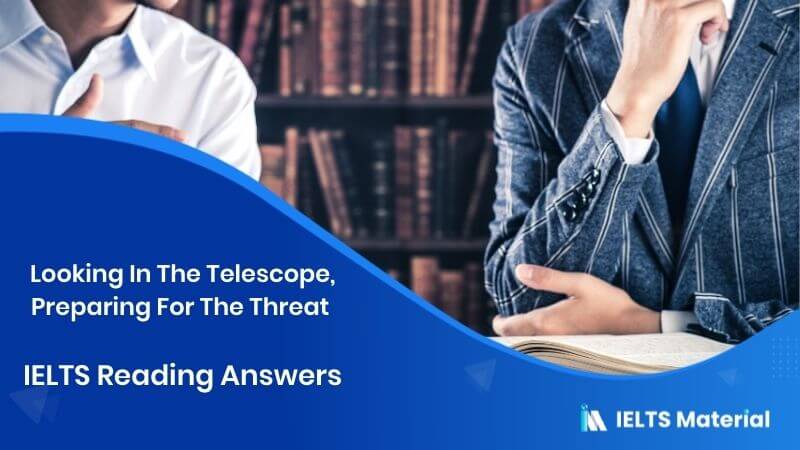


Post your Comments